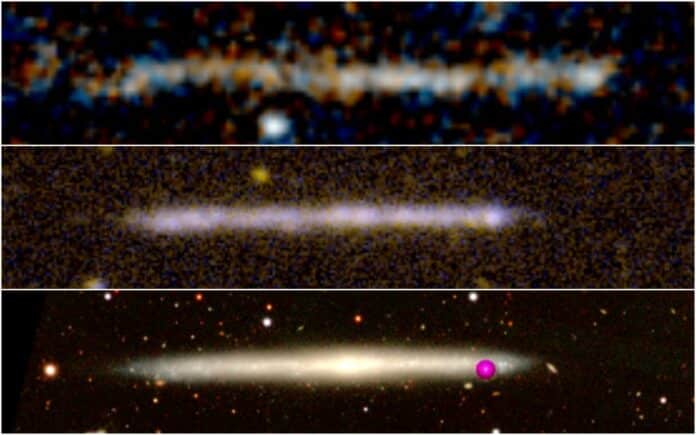A team of researchers at the Instituto de Astrofsica de Canarias (IAC) have conducted research that suggests a recently discovered very thin structure of stars, which the Hubble Space Telescope discovered, maybe a galaxy seen edge-on.
Numerous research teams have had difficulties in figuring out a mystery trail of stars that was produced eight thousand million years ago and recently spotted by the Hubble Space Telescope. Its hugeness is comparable to the Milky Way’s, and the genesis of this extremely long, narrow structure has been the subject of numerous theories.
This star trail may be the result of a supermassive black hole passing through a huge cloud of gas, according to a contentious original hypothesis. The astronomical community’s interest in this concept was rapidly sparked by the necessity of a broad range of intricately complicated, unique circumstances. In order to find less bizarre explanations for the observations, many research teams have kept looking into new and diverse hypotheses.
In a recent investigation, scientists at the IAC concluded that this peculiar arrangement of stars might be explained as a galaxy without a bulge observed from the edge. These galaxies, often known as thin or flat galaxies, are rather typical.
Jorge Sanchez Almeida, an IAC researcher who is the article’s first author, said, “The motions, the size, and the quantity of stars fits what has been seen in galaxies within the local universe. It’s a relief to have found the solution to this mystery, the new proposed scenario is much simpler. In one sense it is also a pity, because the existence of fleeing black holes is expected, and this could have been the first one to be observed.”
The scientists compared the puzzling structure with a well-known local galaxy without a bulge, IC5249, which has a similar mass of stars and found startling agreement to support the notion of the interpretation in terms of a galaxy.
Mireia Montes, an IAC researcher who is a co-author of the article, “When we analyzed the velocities of this distant structure of stars, we realized that they were very similar to those obtained from the rotation of galaxies, so we decided to compare a much closer galaxy, and found that they are extraordinarily similar.”
Ignacio Trujillo, an IAC researcher who has taken part in the study, said, “We also looked at the relation between the mass of the assumed galaxy and its maximum velocity of rotation and discovered that indeed it is a galaxy which behaves like a galaxy. It is an interesting object because it is quite a large galaxy at a very large distance from Earth, where the majority of the galaxies are smaller.”
According to scientists, further studies will offer detailed insights into this object.
Journal Reference
- Sanchez Almeida, Jorge; Montes, Mireia; Trujillo, Ignacio. “Supermassive black hole wake or bulgeless edge-on galaxy?”. Astronomy & Astrophysics, 2023. DOI: 10.1051/0004-6361/202346430
